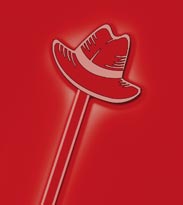The Bahnhofsplatz
Our excursion, which was assisted and guided by the MARKERS, ends at Bahnhofsplatz (6). Paul Max Koebe, a mathematician who collaborated two other scientists, is the final figure of interest on our tour. He was born in Luckenwalde in 1882 and received his PhD in Berlin in 1905. From 1910 to 1935 he worked as a professor and, sporadically, as dean at the universities of Jena and Leipzig. Koebe solved the problem of the uniformization of arbitrary analytic curves. The distortion theorem named after him contributed to the theory of isogonic mapping. He was awarded the King of Sweden's science prize in 1920. Koebe was a member of the Academies of Science in Saxony, Prussia, Lower-Saxony and Finland.
The information provided by the MARKERS is not only concerned with people. Events, vanished buildings like the city castle, the fate of the Jewish community and testimonies of recent history are all brought to life again. Watch out for the various metallic signs with the hat. Hats off to Luckenwalde, they really know how to bring history alive here.
